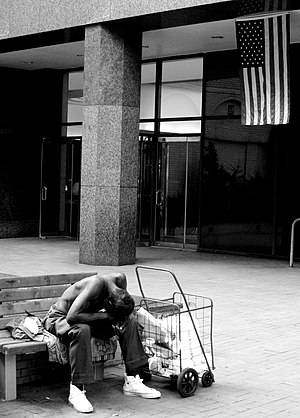Last month the Department of Housing and Urban Development made an announcement that slipped by mostly unnoticed in the holiday furor. The department reported that the number of homeless people in the U.S. declined slightly in 2012, a drop of 0.4 percent to 633,782. The numbers show a continuous five year trend during which the U.S. has reduced homelessness by 5.7 percent even as the poverty rate grew by 20 percent. It should be noted that this announcement is based on a count on a single night last January.
The editors over at Bloomberg seem confident that they have isolated the cause:
The solution, it seems, lies not in publicly sheltering the homeless for sustained periods but in ensuring that they quickly secure their own places to live.
This approach was first applied to the chronically homeless, who made up 16 percent of all cases in 2012. These individuals almost always have disabilities such as mental or physical health problems or addictions. As a result, they fare poorly in conventional homeless programs, which may require compliance with the rules of an emergency shelter — such as sobriety — before allowing them entrance to a transitional shelter. Further compliance, including treatment for substance abuse, for instance, may be required before they can qualify for permanent housing support.
The alternative strategy places the chronically homeless directly into permanent housing while also connecting them to services to address their other challenges. Most will need this support, at government expense, for life. Yet such comprehensive assistance is probably cheaper than leaving the chronically homeless on the streets, because they often end up in hospitals, detox centers or jails, all on the taxpayer’s dime. Those services cost the public $2,897 per individual per month, according to one study in Los Angeles County, versus $605 for supportive housing.
Once more we see the comparison between short-term expense and long-term savings thrown into sharp relief. There is certainly a lot of public money to be saved in finding more effective ways to combat homelessness, but it also brings up another chronic issue: service providers.
No matter what sort of program gets implemented, it all comes down to how efficiently it is done. Within the for-profit prison system we see justice take a sideline to occupancy quotas and profitability. When talking about homeless issues it is likewise important to remember that many of the service providers seeking public money would be out of business if the homeless problem got solved.
I started thinking about this after an interaction with a homeless blogger named Thomas Armstrong in our Google community about homelessness. Here are the paragraphs that stuck with me:
I am increasingly concerned, and am hearing that others’ concerns are increasing, about a lack of help for mentally ill people in Homeless World Sacramento.
There is a feeling that all the public agencies and nonprofits are shirking responsibility to help those who suffer most and are most in need of help. Instead, the homeless-help industry’s interest is turned near-entirely to getting disability incomes for veterans and chronically homeless persons, which sounds more laudable than it is. The reason vets and the chronically homeless are getting so much attention has everything to do with MONEY — that is so the charities can get buck from these homeless people in exchange for services and so that charities can do their crocodile-tears donations-seeking dance.
The state and county remain in fiscal trouble. It is known that services they provide or fund to help poor or mentally-ill people were among the first to be severely cut or ended in response to the budget crisis beginning three or four years ago. Advocates for the mentally ill and families that include a mentally ill member are not politically powerful.
Many seemingly laudable programs can develop tunnel-vision as they seek funding, becoming out of touch with the reality on the streets. Groups like this can often be identified by their avoidance of discussions about how often the new residents are followed up and/or assisted with in-place operators wanting to see them succeed. That they need homeless people in order to keep their doors open makes their operations deserving of scrutiny.
So, how do we make this arrangement more effective? Long-term solutions are certainly proving to be far more effective at getting people off the streets and into homes, but the human element is of grave concern.
What do you think? Is there a way to deploy funding into effective programs while ensuring that it is employed both strategically and effectively? It is a thorny problem and worthy of discussion, so please share your thoughts.
Related articles
- Homeless teens struggling to find warmth in winter (fox13now.com)
- Houston’s Homeless (gobeyondblog.com)
- What Our Community Should Demand to Know about the Homeless Authority (CSAH) [being in disarray] & Homelessness in Savannah (housingfirstsavannah.wordpress.com)
- Proven Reforms Help Beat Homelessness Even in Tough Times – Bloomberg (bloomberg.com)




























